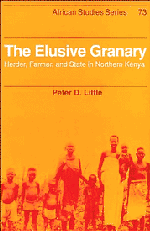Book contents
- Frontmatter
- Contents
- List of illustrations
- List of tables
- Preface
- 1 Introduction: the study of agrarian change among African herders
- 2 Society, ecology, and history
- 3 Markets and the state
- 4 Labor and agropastoral production
- 5 Income, wages, and investment
- 6 Expenditures, consumption, and the food crisis
- 7 Land conflicts and sustainability
- 8 In pursuit of the granary: development responses of community, donor, and state
- Notes
- References
- Index
- AFRICAN STUDIES SERIES
5 - Income, wages, and investment
Published online by Cambridge University Press: 04 August 2010
- Frontmatter
- Contents
- List of illustrations
- List of tables
- Preface
- 1 Introduction: the study of agrarian change among African herders
- 2 Society, ecology, and history
- 3 Markets and the state
- 4 Labor and agropastoral production
- 5 Income, wages, and investment
- 6 Expenditures, consumption, and the food crisis
- 7 Land conflicts and sustainability
- 8 In pursuit of the granary: development responses of community, donor, and state
- Notes
- References
- Index
- AFRICAN STUDIES SERIES
Summary
This chapter broadens the discussion of production by examining its relationship to nonagropastoral activities and investments. The relationships among rural production, nonfarm income, and investment preclude simplistic characterization. Diversification into nonfarm activities, especially wage employment, is a response to low production among the poor and to the need to diversify among the rich. Looking “beyond the herd” shows that nonfarm activities can improve the welfare of certain producer groups while jeopardizing the viability of others. At the lower end of the wealth continuum, pastoralists take on wage employment and dryland agriculture to supplement meager livestock incomes and to meet subsistence costs, while at the upper end, nonpastoral activities are pursued as accumulation strategies that serve to differentiate further the rich from the poor. One is a question of survival, the other of investment. Clearly what Bernstein (1982) calls a “simple reproduction squeeze” exists among II Chamus homesteads, but not all domestic units are affected equally nor are their responses similar.
Disaggregating homestead activities according to whether they result from production or investment strategies is difficult. This is particularly true for livestock, as they are both product and investment, accruing yields of up to 10 percent per annum. Calculating returns to labor in livestock production demonstrates that on average more than 20 percent of annual value derives from investment gains (i.e. herd growth and appreciation), rather than milk and meat production. This sort of capital accumulation distinguishes livestock raising from other productive options in the area. The chapter analyzes the economics of pastoralism, irrigated agriculture, and wage employment among different socioeconomic groups of producers.
- Type
- Chapter
- Information
- The Elusive GranaryHerder, Farmer, and State in Northern Kenya, pp. 91 - 116Publisher: Cambridge University PressPrint publication year: 1992



